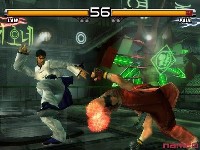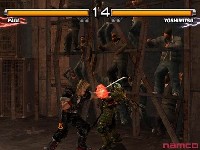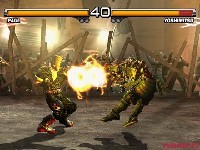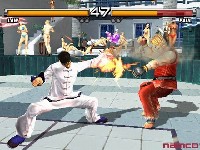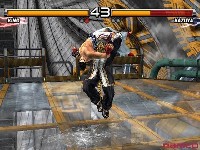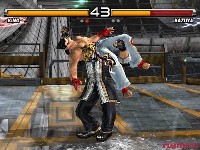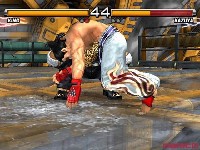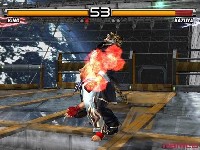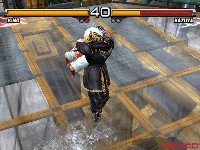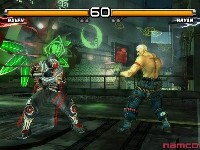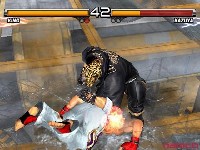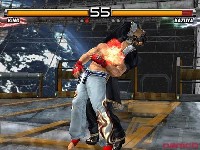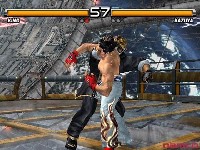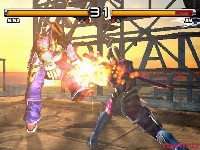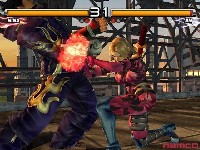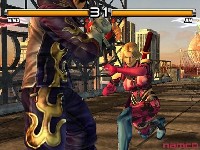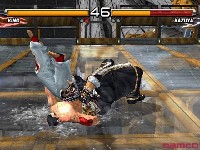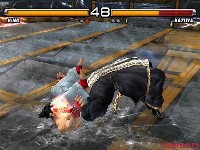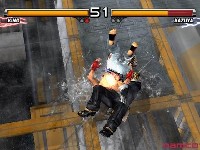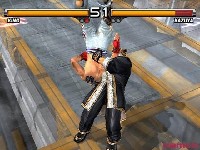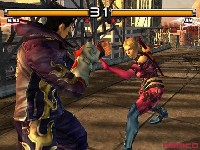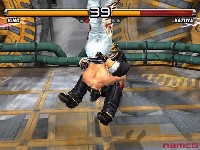Genre: Fighting
Publisher: Namco
Developer: Namco
Release Date: February 25, 2005
Buy 'TEKKEN 5': PlayStation 2
The Tekken series has made some amazing strides in its lifetime, growing from an innovative yet clunky and somewhat contrived 2D fighter composed of blocky 3D characters into something that essentially defines a genre. If you stuck with the series, you would have witnessed its growth to the darling that has captured the attention of so many. Tekken 3 broke into the arcade as a force to be reckoned with, introducing new maneuvers, interesting characters, creative (if a bit eccentric) storylines, and also spawning Tekken Tag. Tekken 4 was a step in the wrong direction, but Namco is quick to learn from its mistakes and took a step back towards combo-heavy game design and faster-paced action. With much excitement among the arcade community, Tekken 5 has arrived.
The Tekken storyline is somewhat akin to what you would get from having a dozen relatively talented writers take turns writing pages of a story while being completely hammered. It is a big confusing – and often convoluted – mess of intertwining plot twists and occasionally contradicting instances. The upside is that this messy ball of twine we call the plot is quite entertaining and interesting, even to those of us who generally could care less.
Tekken 5 follows shortly after Tekken 4, which ended with a large number of explosive robots barging in to blow up Heihachi. A mysterious entity has been buried beneath the building which was blown up, and was luckily freed by the explosion. Being an evil, pissed-off demonic martial artist, the mysterious entity decided that the best way to get revenge and destroy all of "existence" was through a fighting tournament (pass the tequila) …
The gameplay has changed drastically from Tekken 4's very deliberate jab-fest in which 90% of the fight consisted of poking at each other. The change back to the higher-paced, more involved feel that was present in Tekken 3 and Tekken Tag has revitalized the series. Naturally, not many people would want a game where the primary feature was exactly the same as an earlier game with the same name, so there are a plethora of additional intricacies and dynamics.
The most noticeable change would be the three (mostly) brand new characters. The new blood is composed of a Korean Kenpo practitioner who killed his master; a Blade-esque black ninja named Raven who bears an uncanny resemblance to Wesley Snipes; and Asuka, a somewhat new character who is basically Jun from Tekken Tag and Tekken 2 with a new look and a couple of new moves. In my opinion, new characters often add more to a game than anything else, as they provide a whole new learning curve that is much steeper than minor system changes and tweaks. Of course, it also doesn't hurt that these new characters are just plain cool.
The roster has grown from 18 characters in Tekken 4 to 29 characters in Tekken 5. Just in case you didn't do the math in your head, that means that there are eight more character in this installment, not counting the three new combatants. Namco saw fit to bring back a whole slew of favorites from the Tekken franchise, and each has been almost entirely redesigned with new sets of moves, animations and appearances. This huge boost in variety should help to ease the malaise for those of us who got tired with what felt like a minimal cast in Tekken 4.
Another very important change to the system comes in the form of the "crush" system, which includes two varieties, the "High Crush" and the "Low Crush." The overall concept is relatively simple and has been present in other fighting games before. Basically, if I am jumping and kicking at you while you crouch low and sweep, chances are that we are either going to completely miss each other or I am going to hit you without being hit. Sounds like a very logical concept, but it was not always present in the Tekken series and has in fact been absent in many fighting games. The fact that they have incorporated a hardbound system to determine if such collisions will occur has helped to balance the play while creating a very interesting high-reward, high-risk system.
Namco also saw fit to revamp the vast majority of the moves, tweaking them a bit here and there to create a more balanced playing field. There have also been ample changes made to the stage design, most notably the removal of height variances in the terrain, which proved to be somewhat undesirable in the previous installment. Walls, however, are still part of the mix and a very important part at that, as they can easily turn the tide of a fight when an unfortunate opponent gets stuck against one. For those who get tired of walls, Namco has included some of their signature "endless stages," which were present in the older Tekken titles. The endless stages essentially have a background that moves relative to the players, rotating slowly to give the appearance of the fight taking place in a large circle. It is a little difficult to describe the effect, but they make it work in a very smooth and unobtrusive way.
It seems pretty obvious that the game's insides have been returned and retooled for the better. The changes have been a general success and make for an all-around entertaining and fairly balanced title. There are some small imbalances that managed to escape the rigorous testing that I am sure Namco put the game through, but only one or two of them are big enough to really impact gameplay, and I am sure you and your friends can agree to not use combos that will repeat infinitely till the opponent is dead … for sanity's sake, right?
The cosmetic front is also looking up, as every step in the series has increased our expectations for graphical representations. The characters all move fluidly and look as realistic as I have seen to date. The added feature of graphical control to activate the smooth filter (a software device filter that smoothes out the polygons and helps with the aliasing for an all-around prettier experience) is a very nice touch, allowing you to tune the graphics to suit your television.
The older characters receive perhaps the most noteworthy graphical upgrades, as we did not get to see many of them in Tekken 4 so there is a big step in the graphics. Each one has been fully redesigned with new costumes and animations helps to make that transition even more noticeable. It's the little details in the game that really show off Namco's TLC, like the skin looking just about perfect, and the characters' clothing moving as they do. The outfits and character designs are outstanding and generally more creative than before, as most characters have outfits that we would see on teen pop stars.
In general, the stages are downright breath-taking. A couple of the more beautiful stages would be the moonlit flower-filled fields, where the petals of the flowers kick up into the wind and flutter down slowly around the fighters; and the dark insides of an ancient Roman Catholic church where the stained glass and candlelight provide the only sources of illumination. Other stages are not so epic or romantic yet possess other charming qualities. For example, there is a frog that hops about in the graveyard stage, and if one of the fighters falls on it, the frog splats and sends the caricature of an angelic frog ghost floating upwards. Namco has struck a fairly solid balance between creating a large diversity of interesting and fun stages within which to fight.
Tekken 5 includes a large number of bonus features, which are hardly necessary or important to the gameplay itself but make the overall experience more enjoyable and rewarding. The most important of these features would be the character customization, where the player can earn money to purchase costume items and accessories for his character. Items are character-dependent and range from sunglasses to skull and crossbones eye patches to … bunny slippers. Using these customizations, a player can "play doll" with their characters in order to dress them as desired.
Another interesting and enjoyable bonus is the inclusion of the first three Tekken titles, which provides a nice glimpse of the past and allows you to view the progress the game has made, all in one sitting. Perhaps this feature is not a reason to purchase the game, but it was definitely a nice added bonus.
"Devil Within" is the included action platforming adventure bonus game, where players can control Jin and get a chance to experience the story as it happened from Tekken 3 to Tekken 4. The general "Devil Within" experience was pretty poor for me, as it essentially was a watered-down version of an adventure platformer with poor quality controls for both the player and the camera. The camera is stuck firmly behind the character so you end up with an obstructed first-person view. I got so frustrated with the controls – or lack thereof – and camera angles that I was forced to put down the joystick and take a break. Making matters worse was the fact that the levels are exceedingly repetitive and bland to look at. The only redeeming factor of "Devil Within" was the occasionally tricky puzzle that was made overly complicated, thanks to the poor camera implementation.
My biggest qualm with the "Devil Within" bonus is that it required that one of the characters in the game be unlocked. I feel that bonus material should not infringe on the maximum possible enjoyment of the original intended material … and I am not just saying that because I died a dozen times due to a platforming boss where I ended up falling into a pit every few minutes. Honest.
 All things considered, Tekken 5 is an amazingly appealing package for any fighting fan. The fact that they have taken one of the strongest fighting game systems to date and improved on it should be enough reason to make this game worth picking up. Start including all of the various bonus content, from the three older versions of Tekken to the character customization, and yes, even the platforming action adventure game which I didn't like, and I would heartily recommend Tekken 5 to everyone.
All things considered, Tekken 5 is an amazingly appealing package for any fighting fan. The fact that they have taken one of the strongest fighting game systems to date and improved on it should be enough reason to make this game worth picking up. Start including all of the various bonus content, from the three older versions of Tekken to the character customization, and yes, even the platforming action adventure game which I didn't like, and I would heartily recommend Tekken 5 to everyone.
Score: 9.6/10
More articles about Tekken 5







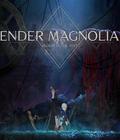
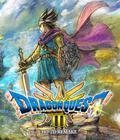

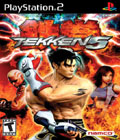 Tekken 5 promises to deliver the ultimate, most visually stunning fighting game experience ever seen in a Tekken game. Tekken 5 brings back the popular cast of characters from the previous Tekken games, along with three new characters, for a total of 20 default characters to start and more to unlock as players progress in the game. Tekken 5 allows players to use their fight money to customize their characters with various accessories such as hats, glasses and an assortment of different costumes.
Tekken 5 promises to deliver the ultimate, most visually stunning fighting game experience ever seen in a Tekken game. Tekken 5 brings back the popular cast of characters from the previous Tekken games, along with three new characters, for a total of 20 default characters to start and more to unlock as players progress in the game. Tekken 5 allows players to use their fight money to customize their characters with various accessories such as hats, glasses and an assortment of different costumes.



